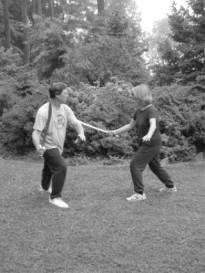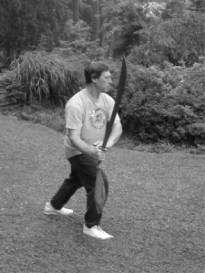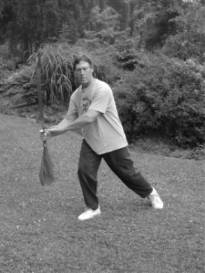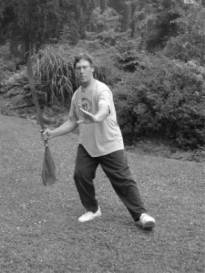 Gilman Studio On-Line Lessons
Gilman Studio On-Line Lessons
Yang Style
Tai Chi Dao/Saber/Broadsword
This Lesson Contains:
Movement # 6 – Cut Horizontally to the Left
This movement is similar to the previous one. Here I step in and grab Stephie’s saber hand as she attempts a cut, and follow with my own cut to her waist. In the previous movement, I used a slicing energy by cutting across the front of the body. This movement employs more of a cutting or horizontal chopping energy. It hits the waist at a perpendicular angle.
A reminder. The Saber form is performed with the same slow, steady, and consistent pace as the long form. Our ultimate objective is to cultivate energy. Even when increasing the speed of this form, do so with a steady pace.
 Stephie has the intention to cut me horizontally to the waist. If I don’t do anything, this is what would happen. I react by stopping her saber hand and cutting her horizontally at the waist. In this set, the application photos are shown first as a group, and then the form pictures.
Stephie has the intention to cut me horizontally to the waist. If I don’t do anything, this is what would happen. I react by stopping her saber hand and cutting her horizontally at the waist. In this set, the application photos are shown first as a group, and then the form pictures.

 1) Following Cut Horizontally to the Right, Stephie attempts to cut my waist.
1) Following Cut Horizontally to the Right, Stephie attempts to cut my waist.
2) I step in with my left foot and grab her saber hand.
 I cut Stephie’s waist while maintaining contact with her saber hand.
I cut Stephie’s waist while maintaining contact with her saber hand.

 Sink the weight deeper into the right foot and roll up the back foot onto the toe. As I do that, I pivot out the right toe to face half way between north and west. I am gathering the chi into my right Kua.
Sink the weight deeper into the right foot and roll up the back foot onto the toe. As I do that, I pivot out the right toe to face half way between north and west. I am gathering the chi into my right Kua.
At the same time, I start to turn the saber over for my forward slice. Rotating the right hand in a clockwise direction until the blade is facing upward does this. The left hand remains on or near the right wrist.
Focus on the energy in the center.
Note: The hand that is not holding the saber usually does one of two things. First it balances the outward force of the saber by moving in the other direction. This is known as Duei La, or counterbalance of forces. The second is staying on or close to the saber hand to assist in creating more power, or staying out of harms way.
Step forward with the left foot to face west. Be sure to step wide enough to accept the releasing torque of the waist and act as a brake. Just touch down the heel. Don’t add weight yet. The torso still faces halfway between north and west.
As you step, the left hand moves to the front of the body, palm facing outward. It is at lower chest level. The hand is at the center of the body. The right hand stays in the same relative position.
Focus on the left palm to grab opponent’s saber hand.
The weight is shifting to the left foot and the torso is turning to the left. The right saber hand has pivoted so that the saber is now parallel to the ground at waist level. The left hand is leading the body movement to the left.
Focus on the left hand for staying in contact and the saber for turning over.
Shift the weight onto the left foot until the nose points to the knee. The torso faces the direction the toe is headed (west).
The saber has moved to the center of the body, with the point facing west. It comes directly out of the center of the body. The left hand has different options for what it does. It can stay attached to the opponent’s hand, like I did in the application picture. It can grab a hold of the right wrist and assist by pulling the saber to the left for a more powerful cut. Or, as pictured here, it can stay near the pommel and help to focus the energy into the saber. Any of these are correct.
Focus on the cutting edge of the saber.





